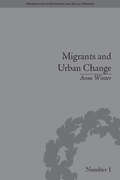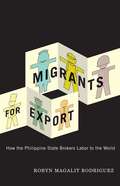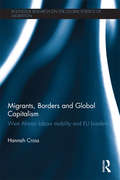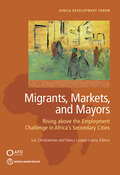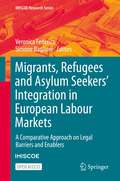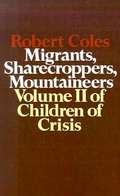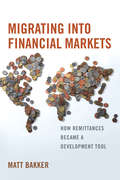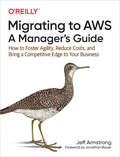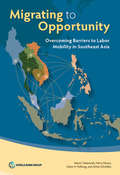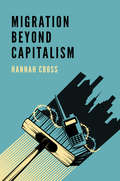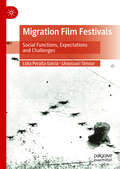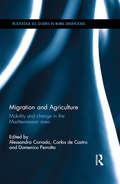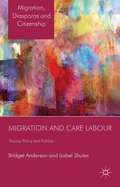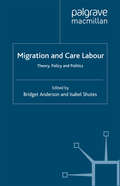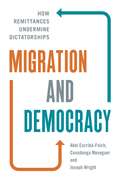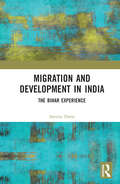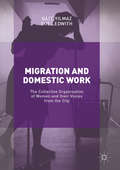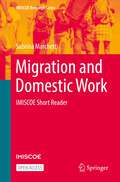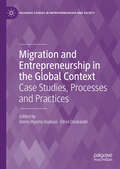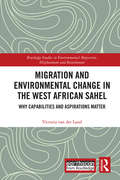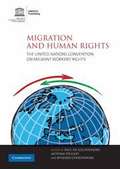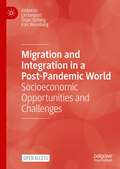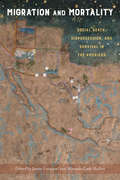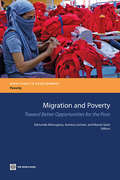- Table View
- List View
Migrants and Urban Change: Newcomers to Antwerp, 1760-1860 (Perspectives in Economic and Social History #1)
by Anne WinterTaking the Belgian city of Antwerp as a case-study, this book argues that the direction of nineteenth century societal change was such as to make some groups of people better suited to reap the benefits of new opportunities.
Migrants for Export
by Robyn Magalit RodriguezMigrant workers from the Philippines are ubiquitous to global capitalism, with nearly 10 percent of the population employed in almost two hundred countries. In a visit to the United States in 2003, Philippine president Gloria Macapagal Arroyo even referred to herself as not only the head of state but also "the CEO of a global Philippine enterprise of eight million Filipinos who live and work abroad. " Robyn Magalit Rodriguez investigates how and why the Philippine government transformed itself into what she calls a labor brokerage state, which actively prepares, mobilizes, and regulates its citizens for migrant work abroad. Filipino men and women fill a range of jobs around the globe, including domestic work, construction, and engineering, and they have even worked in the Middle East to support U. S. military operations. At the same time, the state redefines nationalism to normalize its citizens to migration while fostering their ties to the Philippines. Those who leave the country to work and send their wages to their families at home are treated as new national heroes. Drawing on ethnographic research of the Philippine government's migration bureaucracy, interviews, and archival work, Rodriguez presents a new analysis of neoliberal globalization and its consequences for nation-state formation.
Migrants, Borders and Global Capitalism: West African Labour Mobility and EU Borders
by Hannah CrossPeople from West Africa are risking their lives and surrendering their citizenship rights to enter exploitative labour markets in Europe. This book offers an explanation for this phenomenon that is based on close analysis of the contradictory economic and political agendas that create and constrain labour migration. It shows how global capitalism regulates different stages of the process within an interconnected system of economic dispossession, the construction of an illegal status, border control, labour exploitation and processes of underdevelopment. This is summarised as a regime of ‘unfree labour mobility’. Combined with structural and historical approaches, this book is based on ethnographic research. It incorporates those who are left behind, those who decide to stay, migrants who fail and those who are on the move, alongside clustered migrant communities in Senegal, Mauritania and Spain. The book’s panoramic approach shows how West African ‘step-wise’ journeys to Europe by land and sea sees competing territorial and economic policies regulating an unstable and unpredictable trajectory, creating ‘illegal’ labour through dual logics of border security and selective labour mobility. This book demonstrates that the diverse channels through which people migrate in the modern era are mediated by European states and labour markets, which utilise border regimes to control labour and be globally competitive. The themes and patterns that emerge, in their context of inter-generational change, present a challenge to the accepted wisdom about the individual and household dynamics of labour migration. This book is of interest to students and scholars of migration, transnationalism, politics, security, development, economics, and sociology.
Migrants, Markets, and Mayors: Rising above the Employment Challenge in Africa's Secondary Cities (Africa Development Forum)
by Luc Christiaensen and Nancy Lozano-GraciaResearch on migration and urban development in Africa has primarily focused on larger cities and rural-to-urban migration. However, 97 percent of Africa’s urban centers have fewer than 300,000 inhabitants, and a sizable share of urban migrants come from other urban areas. A more holistic and dynamic perspective, incorporating migration flows along the full urban hierarchy, as well as urban-urban migrants, is needed to better understand and leverage migration for urban development. Migrants, Markets, and Mayors: Rising above the Employment Challenge in Africa’s Secondary Cities draws on demographic data, research literature, key informant interviews, and empirical research to better understand how migrants in Africa’s secondary cities fare in urban labor markets, how they affect aggregate urban productivity, and how mayors can leverage migrants’ potential to the benefit of all. It explores these questions across countries and four urban case settings: Jijiga in Ethiopia, Jinja in Uganda, and Jendouba and Kairouan in Tunisia. Although mayors in secondary cities often see migrants as a burden to their cities’ labor markets and a threat to development, the report finds that migrants contribute increasingly less to urban population growth and that they usually strengthen the resident labor force. The report also finds that labor market outcomes for migrants are at least as good as those for nonmigrants. Africa’s secondary cities are well placed to leverage migration, but evidence-based policies are needed to manage the growth and development of land and labor markets. The report reviews policy options that mayors can take to strengthen the financial, technical, and planning capacity of secondary cities and better leverage migration to benefit migrants and nonmigrants alike. ----------- "Much of the literature on migration to cities examines migration in a nonspatial fashion or focuses on rural-urban migration to the largest, most visible cities. This volume fills a gap by focusing on migration to secondary cities, coming up with a compelling set of facts. Overall, the volume is very well done and sets a benchmark for future research." †“ J. Vernon Henderson, School Professor of Economic Geography, London School of Economics
Migrants, Refugees and Asylum Seekers’ Integration in European Labour Markets: A Comparative Approach on Legal Barriers and Enablers (IMISCOE Research Series)
by Simone Baglioni Veronica FedericoThis open access book discusses how, and to what extent, the legal and institutional regimes and the socio-cultural environments of a range of European countries (the Czech Republic, Denmark, Finland, Greece, Italy, Switzerland and the UK), in the framework of EU laws and policies, have a beneficial or negative impact on the effective capacity of these countries to integrate migrants, refugees and asylum seekers into their labour markets. The analysis builds on the understanding of socio-cultural, institutional and legal factors as “barriers” or “enablers”; elements that may facilitate or obstruct the integration processes. The book examines the two dimensions of integration being access to the labour market (which, translated into a rights language means the right to work) with its corollaries (recognition of qualifications, vocational training, etc.), and non-discriminatory working conditions (which, translated into a rights language means right to both formal and substantial equality) and its corollaries of benefits and duties deriving from joining the labour market. It thereby offers a novel approach to labour market integration and migration/asylum issues given its focus on legal aspects, which includes most recent policy changes and legal decisions (including litigation cases). The robust, evidence-based and comparative research illustrated in the book provides academics and students, but also practitioners and policy makers, with up to date knowledge that will likely impact positively on policy changes needed to better address integration conundrums.
Migrants, Sharecroppers, Mountaineers (Volume 2 of Children of Crisis)
by Robert ColesSince the late 1950's, Robert Coles has been studying, living with, and, above all, listening to the American poor. The result is one of the most vigorous and searching social studies ever undertaken by one man in the United States. Migrants, Sharecroppers, Mountaineers is the second volume in Dr. Coles's award-winning series, Children of Crisis. In it, he listens to three groups: the migrant workers who travel the eastern coast of this country, picking crops day after day; the sharecroppers and tenant farmers who live on isolated southern plantations, just as their ancestors did as slaves; and the mountaineers of Appalachia, whose only choice lies between coal mining and starvation.<P><P> Pulitzer Prize Winner
Migrating into Financial Markets: How Remittances Became a Development Tool
by Matt BakkerA free ebook version of this title is available through Luminos, University of California Press' new open access publishing program for monographs. Visit www.luminosoa.org to learn more. We understand very little about the billions of dollars that flow throughout the world from migrants back to their home countries. In this rigorous and illuminating work, Matt Bakker, an economic sociologist, examines how these migrant remittances--the resources of some of the world's least affluent people--have come to be seen in recent years as a fundamental contributor to development in the migrant-sending states of the Global South. This book analyzes how the connection between remittances and development was forged through the concrete political and intellectual practices of policy entrepreneurs within a variety of institutional settings, from national government agencies and international development organizations to nongovernmental policy foundations and think tanks.
Migrating to AWS: How to Foster Agility, Reduce Costs, and Bring a Competitive Edge to Your Business
by Jeff ArmstrongBring agility, cost savings, and a competitive edge to your business by migrating your IT infrastructure to AWS. With this practical book, executive and senior leadership and engineering and IT managers will examine the advantages, disadvantages, and common pitfalls when moving your company’s operations to the cloud.Author Jeff Armstrong brings years of practical hands-on experience helping dozens of enterprises make this corporate change. You’ll explore real-world examples from many organizations that have made—or attempted to make—this wide-ranging transition. Once you read this guide, you’ll be better prepared to evaluate your migration objectively before, during, and after the process in order to ensure success.Learn the benefits and drawbacks of migrating to AWS, including the risks to your business and technologyBegin the process by discovering the applications and servers in your environmentExamine the value of AWS migration when building your business caseAddress your operational readiness before you migrateDefine your AWS account structure and cloud governance controlsCreate your migration plan in waves of servers and applicationsRefactor applications that will benefit from using more cloud native resources
Migrating to Opportunity: Overcoming Barriers to Labor Mobility in Southeast Asia
by Claire H. Hollweg Mauro Testaverde Harry Moroz SchmillenThe movement of people in Southeast Asia is an issue of increasing importance. Countries of the Association of Southeast Asian Nations (ASEAN) are now the origin of 8 percent of the world's migrants. These countries host only 4 percent of the world's migrants but intra-regional migration has turned Malaysia, Singapore, and Thailand into regional migration hubs that are home to 6.5 million ASEAN migrants. However, significant international and domestic labor mobility costs limit the ability of workers to change firms, sectors, and geographies in ASEAN. This report takes an innovative approach to estimate the costs for workers to migrate internationally. Singapore and Malaysia have the lowest international labor mobility costs in ASEAN while workers migrating to Myanmar and Vietnam have the highest costs. Singapore and Malaysia's more developed migration systems are a key reason for their lower labor mobility costs. How easily workers can move to take advantage of new opportunities is important in determining how they fare under the increased economic integration planned for ASEAN. To study this question, the report simulates how worker welfare is affected by enhanced trade integration under different scenarios of labor mobility costs. Region-wide, worker welfare would be 14 percent higher if barriers to mobility were reduced for skilled workers, and an additional 29 percent if barriers to mobility were lowered for all workers. Weaknesses in migration systems increase international labor mobility costs, but policy reforms can help. Destination countries should work toward systems that are responsive to economic needs and consistent with domestic policies. Sending countries should balance protections for migrant workers with the needs of economic development.
Migration Beyond Capitalism
by Hannah CrossHarshly exploited migrant labour plays a fundamental role in the political economy of contemporary capitalism. The abstract and utopian theorising of many liberals and leftists on the migration question often ignores or downplays patterns of displacement and brutal class dynamics, which divide and weaken working people while empowering the ruling class. In this important new book, Hannah Cross provides a sober analysis of the class antagonisms of migration in the context of the nation, social democracy, and the racialized ordering of the world. Bringing Marxist methodology and strategy to a careful analysis of existing emancipatory movements, she sets out the programmes and approaches that are needed to promote global worker solidarity and create a future in which cheap labour is no longer a mainstay of wealthy economies. This focus on the labouring classes allows her to identify some important new directions for migration in a world beyond capitalism, exploitation and injustice. This book will be essential reading for students, scholars and general readers interested in the politics and political economy of migration in a world unhelpfully caught between racist authoritarian capitalism and the wishful-thinking of contemporary left-liberalism.
Migration Film Festivals: Social Functions, Expectations and Challenges (Framing Film Festivals)
by Lidia Peralta García Lhoussain SimourThis book explores the intersections of migration and film festivals, with particular attention to their social functions . Adopting an interdisciplinary and multi-bottom line perspective, the authors address the purposes and circumstances of migration film festivals; their delimitation as distinct from other genres of festivals; their cinematographic creation; and their approaches to the curation and programming of films. Numerous questions arise in the process: Is social function prone to homogenization among migration film festivals? What are these festivals’ main constraints in negotiating their social functions? What is their actual capacity to foster social transformation? How do we conceive of the fact that most migration festival goers are rarely the ones in need of changing their perceptions? How are migrants actually involved in these cultural events? What are the specific challenges that undermine migration film festivals in achieving a greater social impact, and in turning into true axes of critical reflection towards more empathetic, inclusive and respectful ways of life?
Migration and Agriculture: Mobility and change in the Mediterranean area (Routledge ISS Studies in Rural Livelihoods)
by Alessandra Corrado Carlos De Castro Domenico PerrottaIn recent years, Mediterranean agriculture has experienced important transformations which have led to new forms of labour and production, and in particular to a surge in the recruitment of migrant labour. The Mediterranean Basin represents a very interesting arena that is able to illustrate labour conditions and mobility, the competition among different farming models, and the consequences in terms of the proletarianization process, food crisis and diet changes. Migration and Agriculture brings together international contributors from across several disciplines to describe and analyse labour conditions and international migrations in relation to agri-food restructuring processes. This unique collection of articles connects migration issues with the proletarianization process and agrarian transitions that have affected Southern European as well as some Middle Eastern and Northern African countries in different ways. The chapters present case studies from a range of territories in the Mediterranean Basin, offering empirical data and theoretical analysis in order to grasp the complexity of the processes that are occurring. This book offers a uniquely comprehensive overview of migrations, territories and agro-food production in this key region, and will be an indispensable resource to scholars in migration studies, rural sociology, social geography and the political economy of agriculture.
Migration and Care Labour
by Bridget Anderson Isabel ShutesAcross the world, the provision of care faces mounting challenges what has been widely referred to as a 'crisis of care'. In the global North, international migrants have increasingly supplemented the unpaid or low-paid care labour of women as domestic workers, nannies, care assistants and nurses in the private sphere of the home and in publicly and privately funded care services. This volume brings together international scholars on migration and care to examine the global construction of migrant care labour. The volume makes connections across theory, policy and politics with respect to care, work and migration; the inequalities of gender, race/ethnicity, class, nationality and immigration status that migrant care labour embodies; the inequalities between the global North and South, different regions and countries; the different institutional contexts of care labour that cut across the public and the private; and the different sites of political mobilisation and governance that have developed around migration and care work. "
Migration and Care Labour: Theory, Policy and Politics (Migration, Diasporas and Citizenship)
by B. Anderson I. ShutesThe provision of care has been widely referred to as facing a 'crisis'. International migrants are increasingly relied upon to provide care – as domestic workers, nannies, care assistants and nurses. This international volume examines the global construction of migrant care labour and how it manifests itself in different contexts.
Migration and Democracy: How Remittances Undermine Dictatorships
by Joseph Wright Abel Escribà-Folch Covadonga MeseguerHow remittances—money sent by workers back to their home countries—support democratic expansionIn the growing body of work on democracy, little attention has been paid to its links with migration. Migration and Democracy focuses on the effects of worker remittances—money sent by migrants back to their home countries—and how these resources shape political action in the Global South. Remittances are not only the largest source of foreign income in most autocratic countries, but also, in contrast to foreign aid or international investment, flow directly to citizens. As a result, they provide resources that make political opposition possible, and they decrease government dependency, undermining the patronage strategies underpinning authoritarianism.The authors discuss how international migration produces a decentralized flow of income that generally circumvents governments to reach citizens who act as democratizing agents. Documenting why dictatorships fall and how this process has changed in the last three decades, the authors show that remittances increase the likelihood of protest and reduce electoral support for authoritarian incumbents.Combining global macroanalysis with microdata and case studies of Senegal and Cambodia, Migration and Democracy demonstrates how remittances—and the movement of people from authoritarian nations to higher-income countries—foster democracy and its expansion.
Migration and Development in India: The Bihar Experience
by Amrita DattaThis book deals with a wide range of issues related to rural-urban migration in the context of neoliberal economic development in India. Focusing on three core areas, first it traces state discourses on rural-urban migration in India since the 1930s critically analysing its industrial, labour, rural and urban programmes, and policies. Second, through data on longitudinal surveys undertaken in rural Bihar in 1999, 2011 and 2016, it examines changes in patterns of migration and sources of income; estimates determinants and impacts of migration. Third, based on fieldwork in the village and the city, it presents an in-depth account of a rural-urban migration stream in contemporary India. It shows how, contrary to the results of conventional data sources such as the Census and NSSO, that mobility is high in rural Bihar, and has significantly increased over time as a result of rising labour demand in distant urban markets elsewhere in India. Further, it also provides evidence of decoupling of agriculture from the ‘rural’ in India. Combining quantitative and qualitative methods in development research, this book will be of great interest to scholars and researchers of development studies, migration studies, development economics, sociology, demography, public policy, and South Asian studies.
Migration and Domestic Work
by Gaye Yilmaz Sue LedwithWith female migrants dominating low paid and ever-expanding domestic work worldwide, this book brings together the voices of 120 migrating women of 28 national identities and 10 different religious affiliations. Together they tell how patriarchal and religious gender codes in the family and at work shape their new lives in London, Berlin and Istanbul. Through their own accounts, the study explores the intersecting multiple and gendered identities women carry from their home countries and how these are reshaped, challenged, changed, or not, as they encounter different structures, traditions and cultural codes in their new countries. With women's propensity for collective organising, whether via community, social movements or trade unions as a central theme, the authors also bring together issues of migration, work and identity with trade union and community organizing. Migration and Domestic Work is an important source for scholars and practitioners in each of these fields.
Migration and Domestic Work: IMISCOE Short Reader (IMISCOE Research Series)
by Sabrina MarchettiThis open access short reader offers a systematic overview of the scholarly debate on the experiences of migrant domestic workers at a global level, in the past as well as in present time. It tackles the nexus between migration and domestic work with a multi-layered approach. The book looks into the issue of (paid) domestic work in migratory contexts by investigating the feminization of migration, thereby considering the larger framework within which this specific phenomenon takes place. The author explains notions such as the “international division of reproductive labor” or “global care chains” which emphasize the inequality in the way care and domestic tasks are distributed today between middle-class women in receiving nations and migrant domestic workers. Moreover, the book shows how women migrating to work in the domestic work and private care sector are facing a complex landscape of migration and labor regulations that are extremely difficult to navigate. At the same time, this issue also addresses employers’ households who cannot find appropriate or affordable care among declining welfare states and national workers reluctant to take the job, whilst legal regulations make difficult to hire a domestic worker who is a third country national. As such this book offers an interesting read to academics, policy makers and all those working in the field.
Migration and Entrepreneurship in the Global Context: Case Studies, Processes and Practices (Palgrave Studies in Entrepreneurship and Society)
by Denis Hyams-Ssekasi Eirini DaskalakiPresenting a collection of case studies on immigrant and migrant entrepreneurship, this book offers an understanding of the phenomenon as a creation of a distinctive labor market that leads to innovation, productivity, and economic growth. As such, it contributes to SDG 8: 'Promote sustained, inclusive and sustainable economic growth, full and productive employment and decent work for all.'Reflecting on the increasing interest in the subject, contributors provide new perspectives of migrants in diaspora, thus offering a better grasp of lived experiences. Chapters explore the common adversities that immigrant entrepreneurs face, such as the lack of knowledge in terms of operations of the host country market, dealing with unfair treatment, and the subsequent challenge of building long term relationships with locals. Focusing on individual migrant entrepreneurship cases and the recurrent challenges that such entrepreneurs encounter, many of the chapters are written by academics who are migrants with entrepreneurial experiences, which brings a unique insight into the topic. Exploring issues such as gender and enterprise, family business, and entrepreneurial activities, this distinctive collection provides a comprehensive overview of varied experiences of migrant entrepreneurs in both developed and developing countries.
Migration and Environmental Change in the West African Sahel: Why Capabilities and Aspirations Matter (Routledge Studies in Environmental Migration, Displacement and Resettlement)
by Victoria van der LandThe West African Sahel is predicted to be heavily affected by climate change in the future. Slow-onset environmental changes, such as increasing rainfall variability and rising temperature, are presumed to worsen the livelihood conditions and to increase the out-migration from the affected regions. Based on qualitative and quantitative data from study areas in Mali and Senegal, this book examines the relationship between population dynamics, livelihoods and environment in the Sahel region, focussing specifically on motives for migration. Critiquing the assumption that environmental stress is the dominating migration driver, the author demonstrates the important role of individual aspirations and social processes, such as educational opportunities and the pull of urban lifestyles. In doing so, the book provides a more nuanced picture of the environment-migration nexus, arguing that slow-onset environmental changes may actually be less important as drivers of migration in the Sahel than they are often depicted in the media and climate change literature. This is a valuable resource for academics and students of environmental sociology, migration and development studies.
Migration and Human Rights
by Ryszard Cholewinski Paul De Guchteneire Antoine PécoudTwenty contributions from international academics and practitioners discuss the human rights implications of irregular migration in the EU from theoretical, European, and international perspectives. They analyze public perceptions of irregular migrants, assess the impact of immigration policies, and consider various ways of fostering integration. The papers were originally presented at a 2003 conference held at the U. of Leicester.
Migration and Inequality (Routledge Studies in Development Economics #100)
by Tanja BastiaThe ‘migration-development’ nexus has emerged as an important area of both research and policy over the last ten years. However, most of the interest has focused on the potential that migration holds for poverty alleviation. Relatively little attention has been paid to the relationship between migration and inequality, particularly on inequality as a consequence of migration. This is unfortunate, given that inequality is emerging as an important area of inquiry within development studies. This edited collection explores the relationship between migration and inequality in Africa, Asia and Latin America by taking into account economic and social inequalities. While the focus on inequality as opposed to poverty is in itself original, the book offers additional points of interest. First, it combines chapters on internal and international migration, thereby challenging the current focus in the migration literature that focuses almost exclusively on cross-border migration. Internal migration greatly outnumbers cross-border moves. Yet policy-makers as well as most studies focus on cross-border international migration. We are only just beginning to unravel the relationship between internal and cross-border migration. Second, the theme of inequality complements the existing focus in the migration-development nexus on issues of poverty. Third, the chapters focus on both economic and social inequalities, often combining an analysis of different types of inequalities. The book also covers governance and migrants’ rights; gender and intersectionality; and health. The chapters in this edited volume make an original contribution to debates on the migration-development nexus as well as the literature on inequality, which often tends to focus on economic measurements of inequality at the expense of including a thorough analysis of social inequality.
Migration and Integration in a Post-Pandemic World: Socioeconomic Opportunities and Challenges
by Lin Lerpold Örjan Sjöberg Karl WennbergAs the world emerges from the COVID-19 pandemic, this book explores current migration and integration challenges. Against the background of long-term migration trends, it asks whether the pandemic has changed the patterns observed, transformed the circumstances international migrants face at destination or whether the opportunities and challenges for integration have been altered. Twenty-four researchers have contributed to this volume with research attention on how COVID-19 has affected transnationalism and identity, labour market employment, and impacted the discrimination of migrants in a variety of ways. Loyalties and tensions created by the need to include also hesitant migrant groups in vaccination programmes are explored. The role of cosmopolitanism and welfare chauvinism in narratives on inward migrations flows, the stance of trade unions on migration, the complexities of implementing return policies, and the challenges faced by unaccompanied refugee youth from Afghanistan are also discussed.
Migration and Mortality: Social Death, Dispossession, and Survival in the Americas
by Jamie Longazel and Miranda Cady HallettDeath threatens migrants physically during perilous border crossings between Central and North America, but many also experience legal, social, and economic mortality. Rooted in histories of colonialism and conquest, exclusionary policies and practices deliberately take aim at racialized, dispossessed people in transit. Once in the new land, migrants endure a web of systems across every facet of their world—work, home, healthcare, culture, justice—that strips them of their personhood, denies them resources, and creates additional obstacles that deprive them of their ability to live fully. As laws and policies create ripe conditions for the further extraction of money, resources, and labor power from the dispossessed, the contributors to this vibrant anthology, Migration and Mortality, examine restrictive immigration policies and the broader capitalist systems of exploitation and inequality while highlighting the power of migrants’ collective resistance and resilience. The case studies in this timely collection explore border deaths, detention economies, asylum seeking, as well as the public health and mental health of migrants. Ultimately, these examples of oppression and survival contribute to understanding broader movements for life and justice in the Americas.
Migration and Poverty: Towards Better Migration Opportunities for the Poor
by Marcin Sasin Edmundo Murrugarra Jennica LarrisonThis volume uses recent research from the World Bank to document and analyze the bidirectional relationship between poverty and migration in developing countries. The case studies chapters compiled in this book (from Tanzania, Nepal, Albania and Nicaragua), as well as the last, policy-oriented chapter - illustrate the diversity of migration experience and tackle the complicated nexus between migration and poverty reduction. Two main messages emerge: Although evidence indicates that migration reduces poverty, it also shows that migration opportunities of the poor differ from that of the rest. In general, the evidence suggests that the poor either migrate less or migrate to low return destinations. As a consequence, many developing countries are not maximizing the poverty-reducing potential of migration. The main reason behind this outcome is difficulties in access to remunerative migration opportunities and the high costs associated with migrating. It is shown, for example, that reducing migration costs makes migration more pro-poor. The volume shows that developing countries' governments are not without means to improve this situation. Several of the country examples offer a few policy recommendations towards this end.
